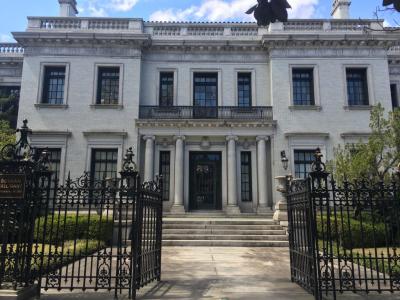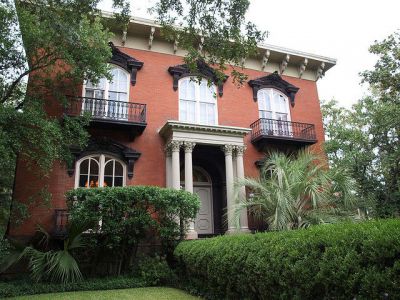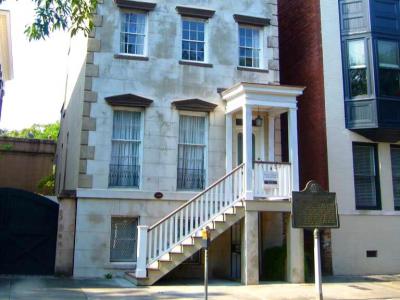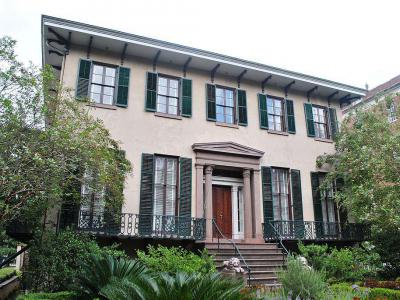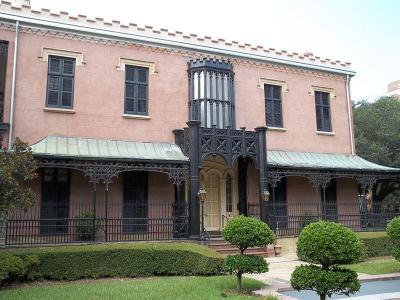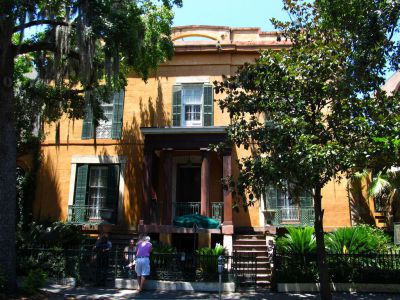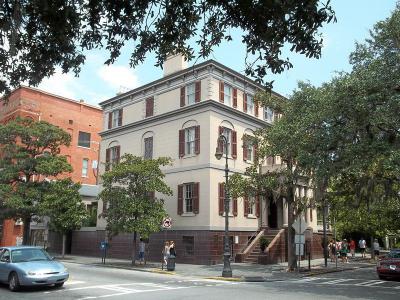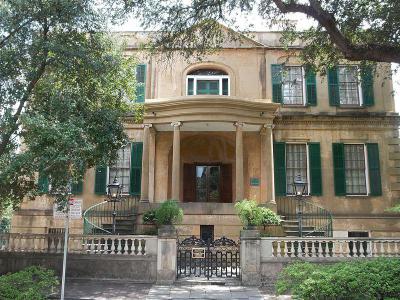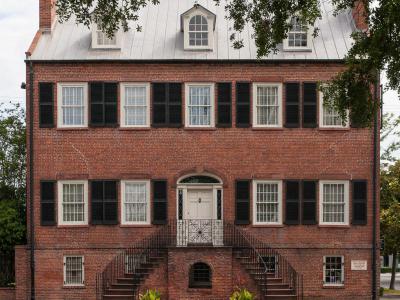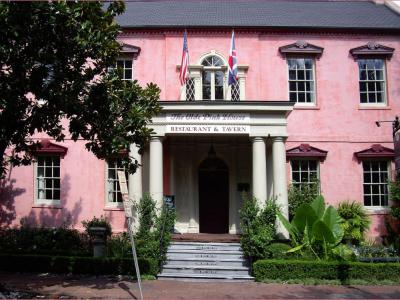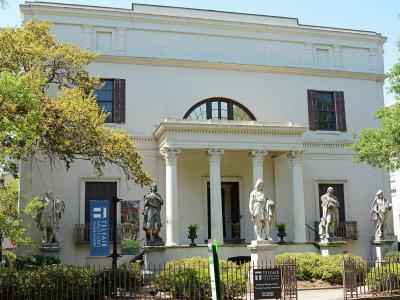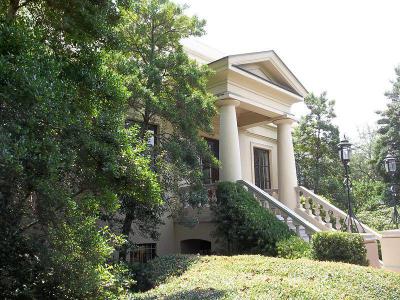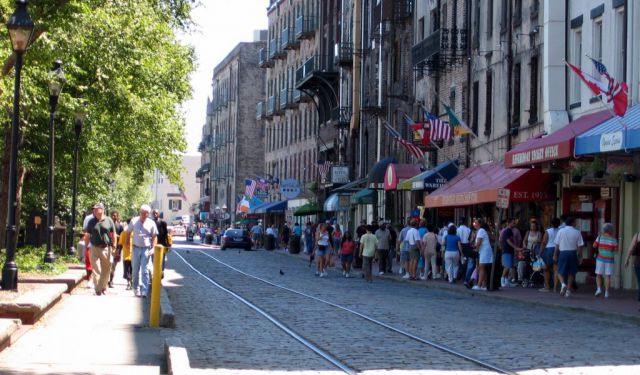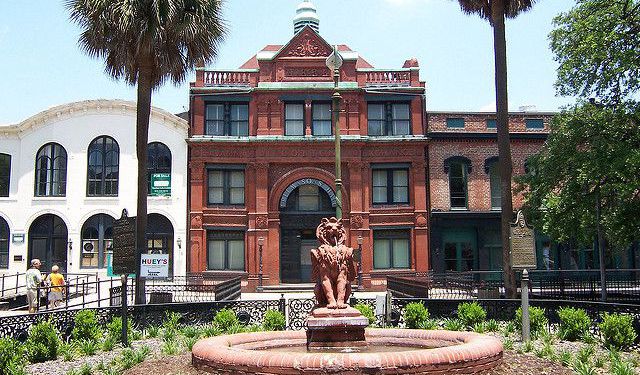Historical Houses Walking Tour (Self Guided), Savannah
Savannah, Georgia breathes history. You can feel it in the cobblestone alleyways and quaint squares dotting the city. An enchanting walk through the heart of Savannah's Historic District (one of the most carefully preserved in the United States) highlights an array of beautiful homes.
Saved by the forward-thinking residents from being bulldozed in the 1960s, these gorgeous structures (with architectural styles spanning two centuries) really catch the eye and offer a glimpse into the daily life of their inhabitants back in time.
Among such are the birthplace of Juliette Gordon Low – founder of the Girl Scouts of the USA; the Telfair Academy of Arts and Sciences – one of the South's first public museums; the Sorrel-Weed House – reputedly the most haunted place in Savannah; and the Owens-Thomas House and Slave Quarters – the stunning example of Regency architecture from 1819; to mention but a few.
Other properties of note include the Mercer-Williams House, made famous by the book and movie "Midnight in the Garden of Good and Evil," and the Green-Meldrim House, once used by General William Sherman as his headquarters during the Civil War. It was here that he gifted President Lincoln Savannah as a Christmas present!
Davenport House: The onsite museum sparked Savannah’s historic preservation movement back in 1955; its gorgeous courtyard area is now a popular spot for quaint wedding celebrations.
Also, the Olde Pink House, while a restaurant today, is one of Savannah's oldest buildings, dating back to the 18th century.
Visiting such historical locations is a fantastic way to immerse yourself in Savannah's captivating history, from its early colonial days to its role in the Civil War and beyond. For a more detailed acquaintance with these and other eclectic mansions that make Savannah such an interesting place, and discover their secrets, take this self-guided walking tour!
Saved by the forward-thinking residents from being bulldozed in the 1960s, these gorgeous structures (with architectural styles spanning two centuries) really catch the eye and offer a glimpse into the daily life of their inhabitants back in time.
Among such are the birthplace of Juliette Gordon Low – founder of the Girl Scouts of the USA; the Telfair Academy of Arts and Sciences – one of the South's first public museums; the Sorrel-Weed House – reputedly the most haunted place in Savannah; and the Owens-Thomas House and Slave Quarters – the stunning example of Regency architecture from 1819; to mention but a few.
Other properties of note include the Mercer-Williams House, made famous by the book and movie "Midnight in the Garden of Good and Evil," and the Green-Meldrim House, once used by General William Sherman as his headquarters during the Civil War. It was here that he gifted President Lincoln Savannah as a Christmas present!
Davenport House: The onsite museum sparked Savannah’s historic preservation movement back in 1955; its gorgeous courtyard area is now a popular spot for quaint wedding celebrations.
Also, the Olde Pink House, while a restaurant today, is one of Savannah's oldest buildings, dating back to the 18th century.
Visiting such historical locations is a fantastic way to immerse yourself in Savannah's captivating history, from its early colonial days to its role in the Civil War and beyond. For a more detailed acquaintance with these and other eclectic mansions that make Savannah such an interesting place, and discover their secrets, take this self-guided walking tour!
How it works: Download the app "GPSmyCity: Walks in 1K+ Cities" from Apple App Store or Google Play Store to your mobile phone or tablet. The app turns your mobile device into a personal tour guide and its built-in GPS navigation functions guide you from one tour stop to next. The app works offline, so no data plan is needed when traveling abroad.
Historical Houses Walking Tour Map
Guide Name: Historical Houses Walking Tour
Guide Location: USA » Savannah (See other walking tours in Savannah)
Guide Type: Self-guided Walking Tour (Sightseeing)
# of Attractions: 12
Tour Duration: 2 Hour(s)
Travel Distance: 3.7 Km or 2.3 Miles
Author: hollyg
Sight(s) Featured in This Guide:
Guide Location: USA » Savannah (See other walking tours in Savannah)
Guide Type: Self-guided Walking Tour (Sightseeing)
# of Attractions: 12
Tour Duration: 2 Hour(s)
Travel Distance: 3.7 Km or 2.3 Miles
Author: hollyg
Sight(s) Featured in This Guide:
- Armstrong House
- Mercer-Williams House
- Flannery O'Connor Childhood Home
- Andrew Low House
- Green-Meldrim House
- Sorrel-Weed House
- Juliette Gordon Low Birthplace
- Owens-Thomas House and Slave Quarters
- Davenport House
- Olde Pink House Restaurant
- Telfair Academy
- Ships of the Sea Maritime Museum
1) Armstrong House
Designed by Savannah, Georgia-based architect Henrik Wallin, this handsome mansion – a nationally significant example of Italian Renaissance Revival style – was built between 1917 and 1919 for the home of Savannah magnate George Ferguson Armstrong (1868–1924), and subsequently was home to Armstrong Junior College.
The house made several appearances in popular culture, having been featured as the school of the daughter of the protagonist in "Cape Fear", the 1962 psychological thriller starring Robert Mitchum, Gregory Peck, Martin Balsam, and Polly Bergen. The house also appeared as the real-life law office of attorney Sonny Seiler in the film "Midnight in the Garden of Good and Evil", a 1997 American crime drama film based on a novel by John Berendt and directed by Clint Eastwood.
Stop by to take your selfie with this historic house before or after strolling to the Forsyth Park nearby!
The house made several appearances in popular culture, having been featured as the school of the daughter of the protagonist in "Cape Fear", the 1962 psychological thriller starring Robert Mitchum, Gregory Peck, Martin Balsam, and Polly Bergen. The house also appeared as the real-life law office of attorney Sonny Seiler in the film "Midnight in the Garden of Good and Evil", a 1997 American crime drama film based on a novel by John Berendt and directed by Clint Eastwood.
Stop by to take your selfie with this historic house before or after strolling to the Forsyth Park nearby!
2) Mercer-Williams House (must see)
The Mercer-Williams House Museum sees a lot of visitors due to its role in the hugely popular "Midnight in the Garden of Good and Evil". While this grand John Norris building is now primarily known as a crime scene involving late antiques dealer Jim Williams and his lover, if you take a tour of the home, you might hear less about all that than you may have expected.
Now proudly owned by Jim Williams's sister, an established academic in her own right, the house deliberately concentrates on the early history of the home and Jim Williams's prodigious talent as a collector and conservator of fine art and antiques. Tours are worth it for art aficionados even though the upstairs, Dr. Kingery's residence, is off-limits.
Williams bought the elegant Italianate mansion, which has been cited as "nationally significant" for its architectural style, in 1969. With its tall arched windows and ornate ironwork balconies, it is considered one of the most beautiful in Savannah.
Why You Should Visit:
Okay, so you only get to see the garden and the first floor, but the house is so interesting and the guides are so committed to telling the stories that it's a worthwhile tour.
Tip:
Try to check the neighborhood out at night, as the garden/park in the center of the block is eerily beautiful and well-lit.
Now proudly owned by Jim Williams's sister, an established academic in her own right, the house deliberately concentrates on the early history of the home and Jim Williams's prodigious talent as a collector and conservator of fine art and antiques. Tours are worth it for art aficionados even though the upstairs, Dr. Kingery's residence, is off-limits.
Williams bought the elegant Italianate mansion, which has been cited as "nationally significant" for its architectural style, in 1969. With its tall arched windows and ornate ironwork balconies, it is considered one of the most beautiful in Savannah.
Why You Should Visit:
Okay, so you only get to see the garden and the first floor, but the house is so interesting and the guides are so committed to telling the stories that it's a worthwhile tour.
Tip:
Try to check the neighborhood out at night, as the garden/park in the center of the block is eerily beautiful and well-lit.
3) Flannery O'Connor Childhood Home
Fans of Southern literature are no doubt familiar with the work of Flannery O'Connor. Before her early death from systemic lupus at age 39, O'Connor wrote two novels ("Wise Blood" and "The Violent Bear It Away") and thirty-two short stories, primarily written in a Southern Gothic style, and usually involving grotesque characters and questions of morals. Many of her works also covered sensitive contemporary issues, like the Holocaust and racial integration.
O'Connor's childhood home was built in 1856, as a very modest, one-story Greek revival home. It remained that way until the 1930s, when it has undergone major renovations, to both the interior and exterior. The living room has been refurbished to restore the beauty of the heart of pine flooring, florid furniture, and delicate lace curtains from O'Connor's time. In 1993, a walled garden was added to the backyard, where O'Connor taught a trained chicken to walk backwards. Her appearance with the chicken was her first taste of publicity, and she called it the "high point" of her life.
Filled with memorabilia from O'Connor's past, the home is operated as a historic house museum and literary center, and one can feel what it must have been like to live there in the 1930s. Admission is $8 for adults, $6 for students and military.
Why You Should Visit:
There are books about and by Flannery for sale, and the tour provides many interesting facts about the events and environment that shaped her unique personality.
Tip:
Try to catch a lecture or reading and enjoy the home in a literature context. The best idea would be to catch the annual Birthday Parade and street fair – everybody dresses up!
O'Connor's childhood home was built in 1856, as a very modest, one-story Greek revival home. It remained that way until the 1930s, when it has undergone major renovations, to both the interior and exterior. The living room has been refurbished to restore the beauty of the heart of pine flooring, florid furniture, and delicate lace curtains from O'Connor's time. In 1993, a walled garden was added to the backyard, where O'Connor taught a trained chicken to walk backwards. Her appearance with the chicken was her first taste of publicity, and she called it the "high point" of her life.
Filled with memorabilia from O'Connor's past, the home is operated as a historic house museum and literary center, and one can feel what it must have been like to live there in the 1930s. Admission is $8 for adults, $6 for students and military.
Why You Should Visit:
There are books about and by Flannery for sale, and the tour provides many interesting facts about the events and environment that shaped her unique personality.
Tip:
Try to catch a lecture or reading and enjoy the home in a literature context. The best idea would be to catch the annual Birthday Parade and street fair – everybody dresses up!
4) Andrew Low House
A major landmark on Lafayette Square is the lovely and stately house designed and built in 1848-49 for wealthy cotton merchant Andrew Low, which combines Grecian details with elements of the Italian Villa style and boasts one of Savannah's most stunning ironwork balconies. The shuttered piazza overlooks a beautiful brick-walled rear garden, and the front garden remains much as it did when first planted, with two hourglass-shaped flowerbeds.
Handsome inside as well as outside, the house features spacious rooms decorated with beautiful plaster cornices and carved woodwork, which were host to several important visitors over the years, including English author William Thackeray and Confederate General Robert E. Lee. In 1886, Low's son married Juliette Gordon, who later founded the Girl Scouts of America. When she died in 1927, she bequeathed her carriage house at 330 Drayton Street (in the rear) to the Girl Scouts.
The interior is decorated in the best examples of high-end furnishings from the 1850. No detail has been spared in textiles, furnishings, artwork, plate, glass and silver. Antiques junkies will go nuts over the furnishings, especially the massive secretary in the parlor, one of only four of this type in existence (a sibling is in NY's Metropolitan Museum of Art).
Why You Should Visit:
The tour guides are very informative and the period furnishings and window coverings add to the experience.
This is one of the few houses that allow taking pictures inside – if you go after hours as part of a 'ghost tour'.
Handsome inside as well as outside, the house features spacious rooms decorated with beautiful plaster cornices and carved woodwork, which were host to several important visitors over the years, including English author William Thackeray and Confederate General Robert E. Lee. In 1886, Low's son married Juliette Gordon, who later founded the Girl Scouts of America. When she died in 1927, she bequeathed her carriage house at 330 Drayton Street (in the rear) to the Girl Scouts.
The interior is decorated in the best examples of high-end furnishings from the 1850. No detail has been spared in textiles, furnishings, artwork, plate, glass and silver. Antiques junkies will go nuts over the furnishings, especially the massive secretary in the parlor, one of only four of this type in existence (a sibling is in NY's Metropolitan Museum of Art).
Why You Should Visit:
The tour guides are very informative and the period furnishings and window coverings add to the experience.
This is one of the few houses that allow taking pictures inside – if you go after hours as part of a 'ghost tour'.
5) Green-Meldrim House
Built between 1853 and 1861 for cotton merchant Charles Green, the Green-Meldrim House – originally the most expensive 19th-century house in Savannah – is one of America's finest and most lavish examples of Gothic Revival architecture. Located in Madison Square, at the corner of West Harris and Bull Streets, it features a stuccoed brick exterior, cast-iron porch, oriel windows and an imposing front cast-iron fence. The main entrance has an iron portico believed to be unique in the United States, with octagonal posts supported by a pair of arches, while a crenelated parapet rings the roof. The interior of the house, following a center-hall plan, retains original woodwork, plaster and ironwork, including a freestanding staircase, in addition to crown moldings, chandeliers, and gilded-frame mirrors imported from Austria.
The house was added to the National Register of Historic Places in 1974 and designated a National Historic Landmark two years later, for having played a key part in Civil War history. In 1864, Union General William T. Sherman occupied the house and used it as a headquarters until the end of the Civil War. It was here that Sherman composed his famous telegram to President Abraham Lincoln, in which he communicated his desire to present to the President "as a Christmas Gift the City of Savannah" along with 150 cannon, plenty of ammunition and about 25,000 bales of cotton. In 1892, local politician and judge Peter Meldrim purchased the property and lived in it for several decades, but later, in 1943 his heirs sold it to the adjacent Saint John's Episcopal Church, which offers tours and uses the premises for meetings and wedding receptions.
Why You Should Visit:
What makes this delightful mansion, with its large and ornate rooms, so worth visiting is the charm and expertise of the 'docents' – the guides whose knowledge is encyclopedic.
The history of General Sherman's stay and his relationship with the owner of the house alone are worth the trip through the house. The tri-fold front doors are another standout.
Tip:
In addition, you may visit Saint John's Church (open each weekday, 11am–1pm) with guided tours available.
The house was added to the National Register of Historic Places in 1974 and designated a National Historic Landmark two years later, for having played a key part in Civil War history. In 1864, Union General William T. Sherman occupied the house and used it as a headquarters until the end of the Civil War. It was here that Sherman composed his famous telegram to President Abraham Lincoln, in which he communicated his desire to present to the President "as a Christmas Gift the City of Savannah" along with 150 cannon, plenty of ammunition and about 25,000 bales of cotton. In 1892, local politician and judge Peter Meldrim purchased the property and lived in it for several decades, but later, in 1943 his heirs sold it to the adjacent Saint John's Episcopal Church, which offers tours and uses the premises for meetings and wedding receptions.
Why You Should Visit:
What makes this delightful mansion, with its large and ornate rooms, so worth visiting is the charm and expertise of the 'docents' – the guides whose knowledge is encyclopedic.
The history of General Sherman's stay and his relationship with the owner of the house alone are worth the trip through the house. The tri-fold front doors are another standout.
Tip:
In addition, you may visit Saint John's Church (open each weekday, 11am–1pm) with guided tours available.
6) Sorrel-Weed House
There are many beautiful antebellum mansions in Savannah, Georgia, but the Sorrel-Weed House, which was the first house in Georgia to be designated as a state landmark in 1953, may be the most beautiful of all. Surely, it's an exceptional example of Greek Revival and Regency Style architecture.
Located in Madison Square, it was designed and built by renowned Irish architect Charles B. Cluskey in 1841 for Francis Sorrel, a commission merchant from the West Indies. The house, which is also a National Trust Historic Landmark, features a parapet with elliptical arches, a sweeping double entrance and Doric columns on the portico with balconies on the first story front windows. An oval shaped library with curved wooden doors is of particular interest.
Note the pinkish color of the house; there's an interesting story there. During the first restoration, the Historic Savannah Foundation didn't want the owner to use it because it wasn't considered as one of Savannah's original colors. However, after scraping off over 20 layers of old paint, the owner was able to prove that it was, in fact, the original color, so it stayed. Today, visitors can enjoy touring the interior – a nice combination of informative, intriguing, and only slightly creepy.
Located in Madison Square, it was designed and built by renowned Irish architect Charles B. Cluskey in 1841 for Francis Sorrel, a commission merchant from the West Indies. The house, which is also a National Trust Historic Landmark, features a parapet with elliptical arches, a sweeping double entrance and Doric columns on the portico with balconies on the first story front windows. An oval shaped library with curved wooden doors is of particular interest.
Note the pinkish color of the house; there's an interesting story there. During the first restoration, the Historic Savannah Foundation didn't want the owner to use it because it wasn't considered as one of Savannah's original colors. However, after scraping off over 20 layers of old paint, the owner was able to prove that it was, in fact, the original color, so it stayed. Today, visitors can enjoy touring the interior – a nice combination of informative, intriguing, and only slightly creepy.
7) Juliette Gordon Low Birthplace (must see)
Juliette Gordon Low is best known as the woman who first organized the Girl Scouts in 1912, after meeting war hero Robert Baden-Powell, founder and first Chief Scout of the world-wide Boy Scout Movement. Always an energetic, happy woman, Low was known for jumping headfirst into new hobbies and interests, and after having learned about the Girl Guides in England, she returned inspired to bring the girl's scouting movement to Savannah, Georgia, and America beyond.
The building itself is a blend of Regency and Victorian designs, with – like many other Savannah houses from the 1800s – a basic floor plan known as a "Savannah box". In this particular case, the basic floor plan was expanded upon to create a grander house, which is considered a National Historic Landmark, both for its age and excellent preservation, and for being the site of Juliette Gordon Low's birth. After its purchase by the Girl Scouts of America in 1953, the property was extensively restored and turned into an educational center and historical museum, as it remains to this day.
Why You Should Visit:
Nice tour, reasonably priced, and there are many interesting things about the house and the lives of the people that lived there, not just Juliette, whose artwork is on display. The gift shop offers a nice variety of Girl Scout memorabilia along with local souvenirs, and you can stroll the gardens without paying. If you were ever a scout, you'll probably love this place.
Tip:
You have to do a guided tour – there is no self-guided option. They rarely book same-day tours, however, so it's best to go online and get advance tickets or purchase them at the door beginning at 10am.
The building itself is a blend of Regency and Victorian designs, with – like many other Savannah houses from the 1800s – a basic floor plan known as a "Savannah box". In this particular case, the basic floor plan was expanded upon to create a grander house, which is considered a National Historic Landmark, both for its age and excellent preservation, and for being the site of Juliette Gordon Low's birth. After its purchase by the Girl Scouts of America in 1953, the property was extensively restored and turned into an educational center and historical museum, as it remains to this day.
Why You Should Visit:
Nice tour, reasonably priced, and there are many interesting things about the house and the lives of the people that lived there, not just Juliette, whose artwork is on display. The gift shop offers a nice variety of Girl Scout memorabilia along with local souvenirs, and you can stroll the gardens without paying. If you were ever a scout, you'll probably love this place.
Tip:
You have to do a guided tour – there is no self-guided option. They rarely book same-day tours, however, so it's best to go online and get advance tickets or purchase them at the door beginning at 10am.
8) Owens-Thomas House and Slave Quarters (must see)
The historic Owens–Thomas House in Savannah, Georgia is one of the finest examples of English Regency architecture in the United States.
The building was completed in 1819 to a design by William Jay, an English architect. His plan was to create a house aesthetically compatible to Bath, England, which is evident in the use of the Bath stone as well as in the sophisticated architectural detail that was meant to add a gentrifying physical ornament to the then-newly emerging Southern port of Savannah. The structure is notable for its early cast-iron side veranda with elaborate acanthus scroll supports on which the Marquis de Lafayette addressed the citizens of Savannah on his visit in 1825.
The house was originally named for its first owner, Richard Richardson, whose family had earned fortune as cotton merchants and bankers. In 1830, the mansion was purchased by the local attorney and politician, George Welshman Owens, and remained in his family for several decades until Owens' granddaughter, Margaret Thomas, bequeathed it to the Telfair Academy of Arts and Sciences, in 1951.
In 1976, the house was designated a National Historic Landmark. Complete with the Slave Quarters, which were uncovered and restored during renovations in the 1990s, the property is now a museum. Its collection contains furnishings and decorative arts from the English Regency period, including possessions of the Owens family dating from 1790 to 1840. Among other exhibits here are English Georgian and American Federal period furniture, early Savannah textiles, silver, Chinese Export porcelain, and 18th- and 19th-century art.
The museum's highlight, though, is the carriage house that once functioned as slave quarters – one of the earliest in existence and best preserved in the American South. Previously inhabited by servants like the nanny, cook, butler and other enslaved workers, the place features slave artifacts of the period.
Although architecturally insignificant, the Slave Quarters is culturally and historically important as the showcase of the African slaves' attempt to maintain their ethnic heritage. The ceiling of the building is painted haint blue, which was customarily used in Gullah culture to deter ghosts or other malevolent spirits.
In the courtyard you can see a small parterre garden designed in 1820 English-American style.
The place is open Sunday through Monday from 12–5pm; and Tuesday through Saturday from 10am–5pm.
Tip:
Museum tours go off every 15 minutes – so try to go with a smaller group!
You can also get a pass to see the Jepson Art Center and the Telfair Museum of Art for a single price of $20 in the space of one week.
The building was completed in 1819 to a design by William Jay, an English architect. His plan was to create a house aesthetically compatible to Bath, England, which is evident in the use of the Bath stone as well as in the sophisticated architectural detail that was meant to add a gentrifying physical ornament to the then-newly emerging Southern port of Savannah. The structure is notable for its early cast-iron side veranda with elaborate acanthus scroll supports on which the Marquis de Lafayette addressed the citizens of Savannah on his visit in 1825.
The house was originally named for its first owner, Richard Richardson, whose family had earned fortune as cotton merchants and bankers. In 1830, the mansion was purchased by the local attorney and politician, George Welshman Owens, and remained in his family for several decades until Owens' granddaughter, Margaret Thomas, bequeathed it to the Telfair Academy of Arts and Sciences, in 1951.
In 1976, the house was designated a National Historic Landmark. Complete with the Slave Quarters, which were uncovered and restored during renovations in the 1990s, the property is now a museum. Its collection contains furnishings and decorative arts from the English Regency period, including possessions of the Owens family dating from 1790 to 1840. Among other exhibits here are English Georgian and American Federal period furniture, early Savannah textiles, silver, Chinese Export porcelain, and 18th- and 19th-century art.
The museum's highlight, though, is the carriage house that once functioned as slave quarters – one of the earliest in existence and best preserved in the American South. Previously inhabited by servants like the nanny, cook, butler and other enslaved workers, the place features slave artifacts of the period.
Although architecturally insignificant, the Slave Quarters is culturally and historically important as the showcase of the African slaves' attempt to maintain their ethnic heritage. The ceiling of the building is painted haint blue, which was customarily used in Gullah culture to deter ghosts or other malevolent spirits.
In the courtyard you can see a small parterre garden designed in 1820 English-American style.
The place is open Sunday through Monday from 12–5pm; and Tuesday through Saturday from 10am–5pm.
Tip:
Museum tours go off every 15 minutes – so try to go with a smaller group!
You can also get a pass to see the Jepson Art Center and the Telfair Museum of Art for a single price of $20 in the space of one week.
9) Davenport House
The Isaiah Davenport House, built in 1820 and threatened with demolition in 1955, is what encouraged concerned citizens of Savannah, Georgia, to recognize the architectural significance of the home and other historical buildings in the city and launch preservation efforts that eventually saved hundreds of structures.
Located on a corner of Columbia Square, the Federal-style building was built by Davenport for his wife, ten children and nine slaves. A century later, the once stately home in a fashionable neighborhood became a rundown and dilapidated rooming house in a seedy part of town. A group of community-spirited citizens gathered to purchase it – the first act of the newly organized Historic Savannah Foundation, which went on to save hundreds of buildings in the city; in fact, in 1955, Davenport House became the Foundation's headquarters. It was opened to the public as a house museum in 1963.
Since the mid-1990s, the museum began a restoration process which resulted in a more authentic experience for visitors, including period wallpaper and room furnishings reflecting the inventory taken at the time of Davenport's death in 1827.
Why You Should Visit:
Although not as opulent as some other houses one can visit in Savannah, the 40-min tour – which starts with a brief video, very well done – is quite appealing. Each room has been carefully renovated with attention given to the tiniest detail, and great pains have been taken to create even the original designs of the floor and the wallpaper.
Tip:
Enjoy the beauty of the garden after your tour but make sure to enjoy the gift shop as well, since profits go for the continual improvement of this beautiful home.
Located on a corner of Columbia Square, the Federal-style building was built by Davenport for his wife, ten children and nine slaves. A century later, the once stately home in a fashionable neighborhood became a rundown and dilapidated rooming house in a seedy part of town. A group of community-spirited citizens gathered to purchase it – the first act of the newly organized Historic Savannah Foundation, which went on to save hundreds of buildings in the city; in fact, in 1955, Davenport House became the Foundation's headquarters. It was opened to the public as a house museum in 1963.
Since the mid-1990s, the museum began a restoration process which resulted in a more authentic experience for visitors, including period wallpaper and room furnishings reflecting the inventory taken at the time of Davenport's death in 1827.
Why You Should Visit:
Although not as opulent as some other houses one can visit in Savannah, the 40-min tour – which starts with a brief video, very well done – is quite appealing. Each room has been carefully renovated with attention given to the tiniest detail, and great pains have been taken to create even the original designs of the floor and the wallpaper.
Tip:
Enjoy the beauty of the garden after your tour but make sure to enjoy the gift shop as well, since profits go for the continual improvement of this beautiful home.
10) Olde Pink House Restaurant (must see)
The Olde Pink House was originally known as Habersham House when it was built in 1789, after its owner, James Habersham, Jr., one of Savannah's most important early cotton factors and founding-family members. Habersham lived there until his death in 1799. The lot was originally a land grant from the British Crown. It survived the Savannah fire of 1796 that destroyed 229 buildings in the city.
In 1812, the home became Planters Bank, the first bank in Georgia. It was at this time that a portico, supported by unfluted Doric columns, was added to the building's main façade, while an extension was built on the northern side.
After the Civil War, the house changed hands several times, becoming an attorney's office, bookstore and Alida Harper Fowlkes' Georgian Tea Room. The building went through extensive restoration to regain its former glory in 1970 and re-opened as a restaurant in 1971.
Today the Olde Pink House Restaurant serves traditional southern and lowcountry cuisine with accompanying live music in Savannah's only 18th-century mansion. If you are visiting Savannah for the first time and only have time to dine at one restaurant, this should be your choice. With antiques, ancestral paintings and fireplaces, and high-end service, guests can enjoy the Southern cuisine in style.
In 1812, the home became Planters Bank, the first bank in Georgia. It was at this time that a portico, supported by unfluted Doric columns, was added to the building's main façade, while an extension was built on the northern side.
After the Civil War, the house changed hands several times, becoming an attorney's office, bookstore and Alida Harper Fowlkes' Georgian Tea Room. The building went through extensive restoration to regain its former glory in 1970 and re-opened as a restaurant in 1971.
Today the Olde Pink House Restaurant serves traditional southern and lowcountry cuisine with accompanying live music in Savannah's only 18th-century mansion. If you are visiting Savannah for the first time and only have time to dine at one restaurant, this should be your choice. With antiques, ancestral paintings and fireplaces, and high-end service, guests can enjoy the Southern cuisine in style.
11) Telfair Academy (must see)
The Telfair Academy is a historic neoclassical Regency-style mansion and another creation of William Jay in Savannah, one of the few of his surviving works. The mansion was built in 1818, originally as a family townhouse belonging to the Telfair family, and as such, was the former home of Alexander Telfair, the son of Revolutionary War patriot and Georgia governor, Edward Telfair.
In 1875 Alexander's sister, Mary, heir to the family fortune and last to bear the Telfair name, bequeathed the house, complete with its furnishings and family collections, to the Georgia Historical Society. After significant renovations, which included the addition of the Sculpture Gallery and the Rotunda, the venue opened to the public in 1886 as a free art museum, being the first art museum in the southeastern United States.
In 1976, the building was declared a National Historic Landmark.
Presently, this is one of three sites owned by Telfair Museums (the other two being the Owens-Thomas House and the new modern-art focused Jepson Center). The Telfair Academy contains two 19th-century period rooms and houses 19th- and 20th-century American and European art from its permanent collection, including paintings, works on paper, sculptures and decorative arts. In addition to these, the Academy houses artworks representing Savannah's history and those from native local artists.
Perhaps the most famous attraction here is the Bird Girl statue (relocated from Bonaventure Cemetery), which was made famous by the John Berendt novel, "Midnight in the Garden of Good and Evil".
In a sense, this place offers a great introduction to Savannah by way of depicting local life from the early 20th century, complemented by a broader selection of American impressionism, American portraiture, and the Ashcan school. Whilst inside, don't miss the upstairs room, holding impressive large-size paintings the likes of which can be found only in Chicago or New York.
In 1875 Alexander's sister, Mary, heir to the family fortune and last to bear the Telfair name, bequeathed the house, complete with its furnishings and family collections, to the Georgia Historical Society. After significant renovations, which included the addition of the Sculpture Gallery and the Rotunda, the venue opened to the public in 1886 as a free art museum, being the first art museum in the southeastern United States.
In 1976, the building was declared a National Historic Landmark.
Presently, this is one of three sites owned by Telfair Museums (the other two being the Owens-Thomas House and the new modern-art focused Jepson Center). The Telfair Academy contains two 19th-century period rooms and houses 19th- and 20th-century American and European art from its permanent collection, including paintings, works on paper, sculptures and decorative arts. In addition to these, the Academy houses artworks representing Savannah's history and those from native local artists.
Perhaps the most famous attraction here is the Bird Girl statue (relocated from Bonaventure Cemetery), which was made famous by the John Berendt novel, "Midnight in the Garden of Good and Evil".
In a sense, this place offers a great introduction to Savannah by way of depicting local life from the early 20th century, complemented by a broader selection of American impressionism, American portraiture, and the Ashcan school. Whilst inside, don't miss the upstairs room, holding impressive large-size paintings the likes of which can be found only in Chicago or New York.
12) Ships of the Sea Maritime Museum
Founded in 1966, the Ships of the Sea Maritime Museum is dedicated to documenting Savannah's maritime heritage. The museum has been located in the William Scarborough mansion since 1994, and is a home to the vast collection of nautical-themed artwork, spread across nine galleries, including carvings, paintings, knotwork and scrimshaw, as well as ship models.
The latter include models of the USS Savannah, the first steamship to cross the Atlantic; the HMS Anne, which carried James Oglethorpe, the founder of Georgia, along with other first settlers of the colony, in 1732; The Wanderer, the last documented ship to bring a cargo of slaves from Africa to the United States, in 1858; and the RMS Titanic, which sank on her maiden voyage in 1912.
In many ways, however, the museum is overshadowed by the magnificent William Scarborough mansion itself, that is currently restored to its original early 19th-century appearance. One of the earliest examples of Greek Revival style in the city, this mansion was built in 1819, designed by the famed English architect, William Jay. The building was commissioned by William Scarborough, president of the Savannah Steamship Company and one of the principal owners of the USS Savannah.
Soon after, it was the focal point of colorful festivities during President James Monroe's visit to the city in 1819 and eventually became a center of Savannah's social life.
The two-story house features Roman-style windows flanking the entrance and a monumental Doric portico with a fanlight overhead. It also boasts the largest gardens in the Savannah Historic District, spread over two acres, featuring mostly the plants native to the area. The gardens also provide venue for the Savannah Music Festival each year.
The latter include models of the USS Savannah, the first steamship to cross the Atlantic; the HMS Anne, which carried James Oglethorpe, the founder of Georgia, along with other first settlers of the colony, in 1732; The Wanderer, the last documented ship to bring a cargo of slaves from Africa to the United States, in 1858; and the RMS Titanic, which sank on her maiden voyage in 1912.
In many ways, however, the museum is overshadowed by the magnificent William Scarborough mansion itself, that is currently restored to its original early 19th-century appearance. One of the earliest examples of Greek Revival style in the city, this mansion was built in 1819, designed by the famed English architect, William Jay. The building was commissioned by William Scarborough, president of the Savannah Steamship Company and one of the principal owners of the USS Savannah.
Soon after, it was the focal point of colorful festivities during President James Monroe's visit to the city in 1819 and eventually became a center of Savannah's social life.
The two-story house features Roman-style windows flanking the entrance and a monumental Doric portico with a fanlight overhead. It also boasts the largest gardens in the Savannah Historic District, spread over two acres, featuring mostly the plants native to the area. The gardens also provide venue for the Savannah Music Festival each year.
Walking Tours in Savannah, Georgia
Create Your Own Walk in Savannah
Creating your own self-guided walk in Savannah is easy and fun. Choose the city attractions that you want to see and a walk route map will be created just for you. You can even set your hotel as the start point of the walk.
African-American Heritage Tour
The history of America has many themes, but the theme of African American history that has touched many the most is the theme of resilience. Indeed, African Americans' enduring strength and resilience in the face of adversity have been the subjects of many songs, books, and movies in recent years. Savannah, Georgia, whose African-American population makes up about 60 percent of total... view more
Tour Duration: 2 Hour(s)
Travel Distance: 4.4 Km or 2.7 Miles
Tour Duration: 2 Hour(s)
Travel Distance: 4.4 Km or 2.7 Miles
River Street Sightseeing and Shopping
The story of Savannah's River Street begins in 1733 with General James Edward Oglethorpe's landing on the bank of the Savannah River and founding the British colony of Georgia. Today, the cobble-stoned River Street caters to a variety of interests, combining the rustic beauty of the past with the energy of the present.
The half-mile-long promenade is one of the city's major... view more
Tour Duration: 1 Hour(s)
Travel Distance: 0.7 Km or 0.4 Miles
The half-mile-long promenade is one of the city's major... view more
Tour Duration: 1 Hour(s)
Travel Distance: 0.7 Km or 0.4 Miles
Savannah Introduction Walking Tour
Savannah may not be the whole of Sweet Georgia, but no Georgia is complete without Savannah, that's for sure.
This coastal city is named after the river upon which it stands, whose name is likely to be the variant pronunciation of “Shawnee”, the Native American tribe which inhabited the area in the 1680s. Alternatively, it could have derived from the Spanish “sabana”, referring to... view more
Tour Duration: 2 Hour(s)
Travel Distance: 3.7 Km or 2.3 Miles
This coastal city is named after the river upon which it stands, whose name is likely to be the variant pronunciation of “Shawnee”, the Native American tribe which inhabited the area in the 1680s. Alternatively, it could have derived from the Spanish “sabana”, referring to... view more
Tour Duration: 2 Hour(s)
Travel Distance: 3.7 Km or 2.3 Miles
Savannah's Historical Churches
The conspicuous churches of various styles and denominations – Catholic, Baptist, Lutheran, Presbyterian, Unitarian, and Methodist – dot the cityscape of Savannah, Georgia, in abundance. With their spires reaching high, as if attempting to touch heaven, these churches stand like sacred sentinels, guarding the city's spiritual heritage and illuminating its architectural grandeur.
The... view more
Tour Duration: 2 Hour(s)
Travel Distance: 2.6 Km or 1.6 Miles
The... view more
Tour Duration: 2 Hour(s)
Travel Distance: 2.6 Km or 1.6 Miles
The Most Popular Cities
/ view all



